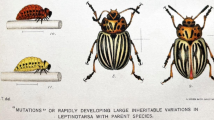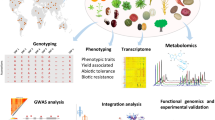Summary
The question which selection method is most suitable for application in populations resulting from crosses of self-fertilizing plants is discussed.
Some factors affecting the value of selecting methods in successive generations of a segregating population are reported. After extensive calculations (§2–§7), the author concludes that the pedigree method, the bulk method and the mass pedigree method are not the most efficient ones, due to the small frequency of desired genotypes and to the possible loss of valuable genotypes by a wrongly directed natural or human selection. He suggests (§ 10) that the best method of making populations more suitable for selection lies in a pre-selection on a gradually increasing number of recessive detrimental genes during consecutive generations, which may be effected by conducting various resistance tests. The efficiency of the “gradual selection” procedure proposed is calculated to be high when compared to the above mentioned methods.
Samenvatting
Na een bespreking van enige factoren die van invloed zijn op de selectie-mogelijkheden in verschillende generaties van een uitmendelende populatie berekent schrijver, dat zowel de lijnselectie in jonge populaties (pedigree method) als de lijnselectie in oudere populaties (bulk method) en het bijeen voegen van door lijnselectie in jonge populaties verkregen materiaal als uitgangspunt voor latere lijnselectie (mass pedigree method) onvoldoende waarborgen bieden dat het best mogelijke genotype door de kweker ook werkelijk uit de populatie geïsoleerd kan worden. Bij toepassing van bewerkelijke en daarom kostbare lijnselectie in jonge populaties wordt reeds in sterk heterozygoot materiaal op opbrengst geselecteerd. Afgeleid wordt (§2 en §3), dat dientengevolge gemakkelijk dragers van belangrijke genencombinaties verloren kunnen gaan. Bij toepassing van de lijnselectie in oudere populaties kunnen door verkeerd gerichte natuurlijke selectie (§9) eveneens waardevolle genotypen uit de populatie verdwijnen. Beide gevaren bestaan in verminderde mate, indien het door lijnselectie verkregen materiaal bijeengevoegd wordt tot uitgangsmateriaal voor latere lijnselectie (§9).
Afgeleid wordt dat bovenstaande bezwaren het best vermeden kunnen worden door de jonge populaties te onderwerpen aan een beperkt aantal resistentie-tests en daarop geen andere selectiemaatregelen toe te passen. Daar een voorselectie op dominante schadelijke genen in de eerste generaties niet aanbevelenswaardig is (§2) dienen de op aanwezigheid onderzochte vatbaarheden recessief te vererven. Dit is met het merendeel der resistenties het geval. Aanbevolen wordt deze voorselectie in latere generaties trapsgewijs uit te breiden over een groter aantal factorenparen (“gradual selection”, §7 en §10). Blijkens tabel 4 is dit mogelijk door in iedere generatie een constant of afnemend percentage planten aan te houden. Bij toepassing van de geschetste werkwijze is de populatie reeds na enkele jaren rijp voor lijnselectie, zodat haar efficiency in vergelijking met die der gecritiseerde methoden hoog genoemd mag worden.
Similar content being viewed by others
Literature cited
Atkins, R. E. and Murphy, H. C., Evaluation of yield potentialities of oat crosses from bulk hybrid tests. Agr. J. 41 (1949): 41–45.
Banga, O., Inleiding tot de plantenveredeling. Tjeenk Willink, Zwolle. 1953: 275–311.
Harrington, J. B., The mass-pedigree method in the hybridization improvement of cereals. J. Am. Soc. Agron. 29 (1937): 379–384.
Kalton, R. R., Breeding behaviour at successive generations following hybridization in soybeans. Iowa Agr. Exp. Sta. Res. Bull. 358 (1948): 671–732.
Keuls, M., The non-importance of linkage in breeding self fertilizing crops. Euphytica 4 (1955): in the press.
Löhner, L., Die Inzucht. Freising-München. 1929: 61.
Palmer, T. P., Populations and selection studies in a Triticum cross. Heredity 6 (1952): 171–185.
Sirks, M. J., Die Verschiebung genotypischer Verhältniszahlen innerhalb Populationen laut mathematischer Berechnung und experimenteller Prüfung. Med. Landbouw Hogeschool Wageningen, 26 (1923) nr 4: 1–40.
Suneson, C. A. and Stevens, H., Studies with bulked hybrid populations of barley. Techn. Bull. 1067 (1953) U.S.D.A., 14 pp.
Author information
Authors and Affiliations
Additional information
The author wishes to thank Prof. Dr J. C. Dorst and Mr M. Keuls for their helpful criticism. To the former he is also grateful for kind permission to publish this part of a M. Sc. thesis and to the latter for valuable mathematical suggestions and aid.
Rights and permissions
About this article
Cite this article
van der Kley, F.K. The efficiency of some selection methods in populations resulting from crosses between self-fertilizing plants. Euphytica 4, 58–66 (1955). https://doi.org/10.1007/BF00042417
Received:
Issue Date:
DOI: https://doi.org/10.1007/BF00042417




